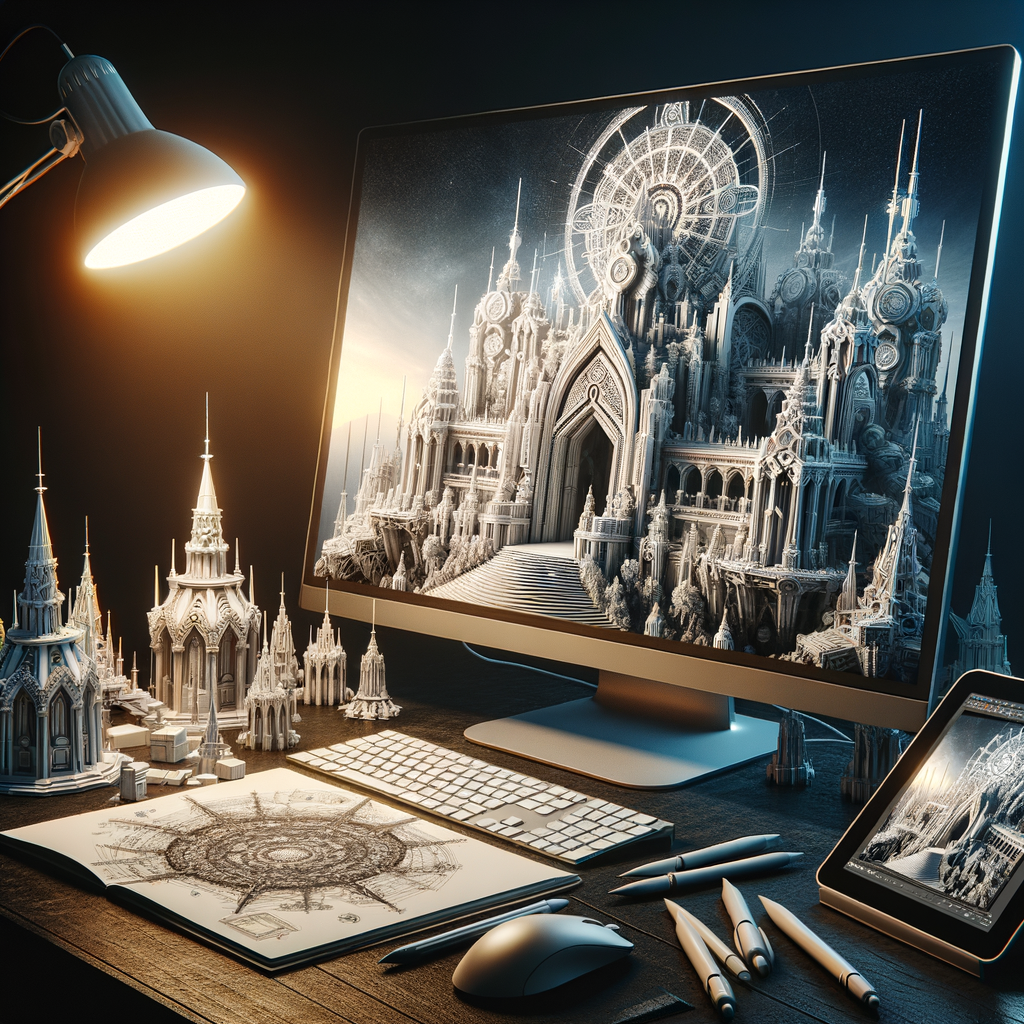
Stunning 3D Modeling Prompts: Your Ultimate Guide To Success
- Understanding 3D Modeling: A Quick Primer
- Importance of Using Prompts in 3D Modeling
- Types of 3D Modeling Prompts
- Object-Based Prompts
- Scene-Based Prompts
- Character Prompts
- How to Choose the Right Prompt
- Boosting Creativity with 3D Modeling Prompts
- Set Goals
- Collaborate with Others
- Limitations can Spark Creativity
- Popular Software for 3D Modeling
- Advanced Techniques for Enhancing 3D Models
- Texturing and Materials
- Lighting and Rendering
- Rigging and Animation
- Presenting Your 3D Models
- Use Turntables
- High-Quality Renderings
- Generate Context
- Engaging with the 3D Modeling Community
- Online Forums
- Social Media
- Workshops and Tutorials
- Overcoming Challenges in 3D Modeling
- Creative Blocks
- Technical Difficulties
- Time Management
- Conclusion: Embrace the World of 3D Modeling
- Frequently Asked Questions (FAQs)
- References
Understanding 3D Modeling: A Quick Primer
3D modeling has gained tremendous popularity in recent years. Artists and designers use it for various applications, from video games to animation and product design. At its core, 3D modeling involves creating a digital representation of an object or scene in three dimensions. This process allows for a more realistic understanding of forms, materials, and even movements.
The variety of 3D modeling software available today caters to different skill levels and purposes. Programs like Blender, Maya, and 3ds Max offer impressive capabilities for both beginners and seasoned professionals. As 3D modeling continues to evolve, so do the techniques and prompts used to create stunning visuals. In this guide, we will explore some inspiring prompts that can help you unleash your creativity and refine your skills.
Importance of Using Prompts in 3D Modeling
When starting a new project, finding inspiration can be daunting. This is where prompts come in handy. A well-thought-out prompt serves as a launching pad for your imagination, guiding your creative process while also challenging your existing skills. It pushes you to think beyond your usual boundaries.
Prompts can vary greatly in complexity and scope. Some may encourage you to create objects, while others may challenge you to design entire environments. By using prompts, you can focus on specific aspects of 3D modeling, such as lighting, textures, and composition. This focus can lead to dramatic improvements in your work over time.
Types of 3D Modeling Prompts
Object-Based Prompts
Object-based prompts center on specific items you can model. This approach allows you to concentrate on details and craftsmanship. For instance:
– Everyday Objects: Model items like a coffee cup or an old clock. This kind of modeling helps you practice round shapes and textures.
– Futuristic Gadgets: Design a sci-fi device. This will challenge your creativity and force you to think about functionality.
These prompts encourage skill-building and creativity. They can be as simple as crafting a toy or as elaborate as designing a futuristic vehicle.
Scene-Based Prompts
Scene-based prompts ask you to create entire environments. This type can immerse you in various design elements. For example:
– A Bustling Marketplace: Create a scene filled with stalls, colorful awnings, and bustling crowds. It requires attention to spatial arrangements and storytelling through elements.
– A Tranquil Park: Model a peaceful natural setting complete with trees, benches, and a pond. This prompt focuses on creating balance and harmony within the space.
These prompts provide a broader canvas for your skills, allowing you to explore lighting, composition, and ambient factors.
Character Prompts
Character modeling poses unique challenges. Crafting a character involves understanding human (or non-human) anatomy, animations, and textures. Here are a couple of examples:
– Fantasy Creatures: Design a dragon or a mythical beast. Here, you get to explore imaginative features, textures, and color schemes.
– Stylized Humans: Create a cartoon character that exaggerates physical traits. This allows for creativity while maintaining some form of realism.
Character prompts offer an opportunity to highlight your skills in anatomy and expression.
How to Choose the Right Prompt
Selecting a suitable prompt can significantly impact your project’s outcome. First, consider your skill level. Beginners may benefit from simpler, object-based prompts that allow for practice in foundational skills. More advanced modelers can explore complex scenes or characters to challenge themselves.
Also, think about your interests. If you love fantasy elements, opt for prompts focusing on mythical creatures or magical landscapes. This excitement can motivate you to complete the project.
Lastly, don’t shy away from experimenting. Sometimes, mixing different prompt types can lead to unexpectedly delightful results. For instance, modeling a character in a vivid scene can enhance your storytelling abilities.
Boosting Creativity with 3D Modeling Prompts
Using prompts effectively requires some strategies to keep the creative juices flowing. Here’s how you can maximize your experience:
Set Goals
Define specific objectives for each modeling session. Whether it’s mastering new software features or improving your texturing skills, having clear goals can streamline your focus and efforts.
Collaborate with Others
Reach out to fellow artists. Sharing your prompts and ideas can ignite fresh perspectives. You might discover new techniques or styles that can inspire your work.
Limitations can Spark Creativity
Sometimes, imposing restrictions can increase creativity. For example, choose a limited color palette or a specific geometry. These limitations encourage you to think outside the box and find innovative solutions.
Popular Software for 3D Modeling
To bring your prompts to life, you need the right software. Here’s a look at some of the most popular choices:
| Software | Best For | Key Features |
|————-|——————————-|————————————|
| Blender | General Use | Open-source, extensive plugins |
| Maya | Animation and Games | Advanced rigging and animation tools |
| 3ds Max | Architectural Visualization | Strong modeling tools |
| ZBrush | Sculpting | High-detail sculpting capabilities |
| SketchUp | Beginners and Architecture | Intuitive interface, easy to learn |
Each program has its unique strengths. Choose one that aligns with your preferred 3D modeling style and goals.
Advanced Techniques for Enhancing 3D Models
As you continue to practice, brushing up on advanced techniques can elevate your models. Here are a few methods to enhance your 3D modeling skills:
Texturing and Materials
Textures bring depth to your models. Spend time experimenting with different materials, from wood to metal or even fabric. Use UV mapping techniques to wrap textures accurately around your objects.
Lighting and Rendering
Proper lighting can make or break your scenes. Experiment with various lighting setups—key light, fill light, and ambient light—to highlight different aspects of your model.
Rigging and Animation
If you work with characters, understanding rigging is vital. It involves creating a skeletal structure that allows for movement. Explore basic animation techniques to bring your characters to life.
Presenting Your 3D Models
Completing a project is just the beginning. Presenting your work effectively is crucial in showcasing your skills. Here are tips to improve your presentations:
Use Turntables
Creating a turntable animation allows viewers to see your model from all angles. This dynamic approach adds an interactive element to your presentation.
High-Quality Renderings
Invest time in creating detailed renderings. Ensure your lighting, textures, and settings are perfected before rendering. High-quality images leave a lasting impression.
Generate Context
Showcase your models in relevant contexts. For instance, if you model a car, place it in a city or rural setting. This helps viewers visualize its practicality and design.
Engaging with the 3D Modeling Community
Networking can significantly enhance your learning experience. Connecting with other 3D modeling enthusiasts can provide support, feedback, and inspiration. Here are some platforms to consider:
Online Forums
Websites like ArtStation and DeviantArt are excellent for sharing your work and getting feedback. Participate in discussions and challenges to engage with fellow artists.
Social Media
Platforms like Instagram and Pinterest have thriving 3D art communities. Share your progress to receive feedback and find new prompts to explore.
Workshops and Tutorials
Consider attending online webinars, workshops, or tutorials. These resources can help you stay updated on trends and techniques in the 3D modeling realm.
Overcoming Challenges in 3D Modeling
Every artist faces challenges, and 3D modeling is no exception. Below are common obstacles and strategies to overcome them:
Creative Blocks
Creative blocks can stop you in your tracks. When this happens, take a break. Explore other art forms, or simply step away from your computer. Often, a fresh perspective can rejuvenate your creativity.
Technical Difficulties
Software can sometimes misbehave. Familiarize yourself with community forums for your chosen software. You can often find solutions to common problems or ask for help.
Time Management
Balancing multiple projects can lead to stress. Prioritize your tasks and break them into manageable steps. This approach can reduce feelings of being overwhelmed.
Conclusion: Embrace the World of 3D Modeling
3D modeling is a fascinating field that combines art, technology, and creativity. Using prompts can significantly enhance your skills and inspire your imagination. By exploring different types of prompts, selecting the right software, and embracing community and collaboration, you’re on the path to success.
Don’t forget to challenge yourself. Whether you’re a beginner or an advanced modeler, there’s always something new to learn. The world of 3D modeling is vast, and your journey has just begun!
Frequently Asked Questions (FAQs)
1. What software should I start with for 3D modeling as a beginner?
Blender is highly recommended as it’s free and has a wide range of features suitable for beginners.
2. How can prompts improve my 3D modeling skills?
Prompts provide specific challenges that encourage creativity and help you focus on different aspects of modeling.
3. Are there any free resources for learning 3D modeling?
Yes, there are many online platforms like YouTube, Coursera, and free community resources where you can learn 3D modeling.
4. How important is texturing in 3D modeling?
Texturing adds realism to your models. It’s crucial to learn texturing techniques to enhance your work’s visual quality.
5. Can I model characters without prior experience?
Yes, you can start with simpler character models and gradually work your way up to more complex designs.
6. What is the best way to critique my own models?
Take a break and return to your work with fresh eyes. Compare it against your goals or feedback from others to assess improvements.
7. How do I showcase my 3D models online?
You can use platforms like ArtStation, Instagram, or even your own website to share and promote your work.
8. Is there a community for 3D modelers?
Absolutely! There are numerous forums, social media groups, and local meetups where you can connect with other 3D artists.
9. How can I improve my lighting skills in 3D modeling?
Experiment with different lighting setups and study photography principles. Practicing with various scenarios can significantly improve your lighting skills.
10. How can I stay updated on trends in 3D modeling?
Follow industry leaders, join relevant forums, and participate in workshops or webinars to keep up with the latest trends.
References
1. Blender
2. Maya
3. 3ds Max
4. ArtStation
5. DeviantArt
6. CGCookie
By following the guidelines in this comprehensive guide, immerse yourself in the creative world of 3D modeling. Happy modeling!

